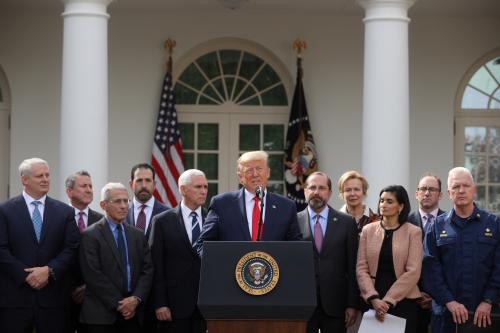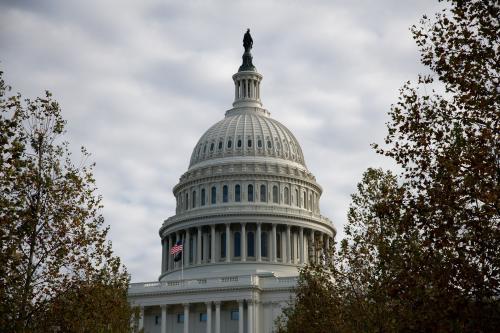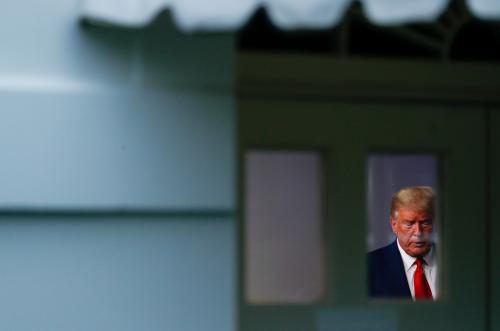As news began to leak out that the White House was thinking about winding down the coronavirus task force, it was greeted with some consternation. After all, we are still in the midst of a pandemic—we need the president’s leadership, don’t we? And then, in an abrupt turnaround, President Trump reversed himself and stated that the task force would go on indefinitely.
So should the task force continue? Well, no.
Frankly, it’s better that this president and this White House get out of the way and let the government do its work. White House task forces are never a substitute for government agencies that have expertise, authority and operational capability. In spite of high “ratings” (the only way Trump seems to measure success), the daily briefings have been a flop any way you look at it. Trump’s halting presentations and erratic behavior (the most outrageous being when he seemed to suggest that people should drink bleach to prevent the virus) have not helped him politically; he is now in danger in some of the crucial swing states he needs to win in November. Nor has he generated confidence in a frightened country. A recent analysis of his briefing remarks illustrates that he has spent very little time consoling the country and too much time complaining about his treatment at the hands of the press and blaming Obama.
But perhaps more importantly, in times of crisis the White House is not “operational.” It has to rely on other agencies to actually do things. For instance, the White House can’t dole out money to buy masks but the Federal Emergency Management Agency (FEMA) can. Earlier this year it gave Colorado $16 million for “Personal Protective Equipment (PPE) such as disposable gowns, masks, face shields, safety glasses and gloves, sanitizer, respirators, and ventilators to assist hospitals, medical clinics, city and county governments, and certain private-non-profits across the state.” Nor does the White House decide which companies will get the Emergency Use Authorizations needed to develop tests—the Food and Drug Administration does that.
To understand the limits of a White House in an emergency we need to go back to the months following our last truly national crisis—the attacks on 9/11. Initially, President George W. Bush resisted calls from Congress to establish a Department of Homeland Security, insisting that the needed coordination could be done from the White House. Instead of supporting a new department he made former Governor Tom Ridge (R-PA) the White House homeland security “czar.” Creating “czars” is a favorite trick up the sleeve of incumbent presidents who need to show that they are doing something while the rest of the government gets its act together, and it’s a way to try to centralize power and make it look like the president is in control.
For the next 16 months, Ridge served as Director of the Office of Homeland Security. For the most part, his White House stint was a study in humility for a capable former governor who was accustomed to actually doing things. With the country on high alert for another terrorist attack, one of Ridge’s first acts was to create a color-coded “Homeland Security Advisory System” on March 11, 2002. It looked, frankly, like a pretty lame response to a threat that was still mysterious and not well understood. The system was immediately criticized as too vague and was skewered by Darrell Hammond on Saturday Night Live’s March 16 cold open.
In September and October of 2001, the United States was hit by a series of anthrax attacks. The deadly powder was sent to two Senate offices (including the Senate Majority Leader Tom Daschle) and to several media outlets. The highly dangerous attacks killed five people, made twenty-two others very sick and gave a country still freaked out by 9/11 another threat to worry about—one that could be delivered through the mail and kill you. The anthrax letters were eventually traced to a domestic terrorist, Dr. Bruce Ivins, who committed suicide before he could be tried.[1] However, as the country panicked over the possibility of more bio-terror attacks, Tom Ridge was reduced to playing master of ceremonies to a series of other government officials who had actual knowledge and real authority over the issue.
Eventually Bush himself had to admit that a White House office was not sufficient to protect the nation. In November 2002, President Bush signed a bill creating the Department of Homeland Security and Tom Ridge was named its first secretary in January 2003.
The White House Coronavirus Task Force has been, at its best, a showcase for the parts of the government that are doing the real work of responding to the crisis; at its worst, it has been downright dangerous. Sometimes, when real information has been conveyed by experts such as Dr. Anthony Fauci and Dr. Deborah Birx, the president has stood idly by—a mere master of ceremonies. More damage has been done, however, from the president’s attempts to get into the mix. It has been reported that he usually did not attend the actual task force meetings and it showed—he read prepared statements as if he was seeing them for the first time. And more seriously, he mislead the public who tuned in looking for guidance on whether to wear masks and whether hydroxychloroquine was a miracle drug. His worst moment came when he seemed to suggest that ingesting bleach might cure the virus.
In the meantime, Jared Kushner, the president’s son-in-law, was put in charge of a supply chain task force. Kushner had no experience in this area nor did the volunteers he assembled. According to reporting by the New York Times, the task force got in the way of the professionals and prioritized friends of the president. The result was more bureaucratic chaos.
A final reason for the White House to get out of the way is that when the White House runs the show, responses are bound to become politicized. Take for example the color-coded threat level advisory. In his book Test of Our Times, Ridge admitted that Secretary of Defense Donald Rumsfeld and Attorney General John Ashcroft had lobbied him (unsuccessfully) to help President Bush’s re-election chance by raising the threat level days before the 2004 general election.
The federal government does not need presidential approval to form a task force. In the midst of this crisis, the CDC, NIH, FDA and FEMA—the lead agencies—will continue to coordinate. Dr. Fauci and the other officials involved will continue to do press conferences and let the public know what it needs to know. History is filled with presidents trying to run things they know little about—President Lyndon Johnson used to go down to the Situation Room and preside over bombing raids in Vietnam. Trump should stop opining about diseases.
Get rid of the White House task force—before it screws up something else and kills again.
[1] For an excellent review see: Public health leaders cite lessons of 2001 anthrax attacks. Center for Infectious Disease Research and Policy, University of Minnesota.
The Brookings Institution is committed to quality, independence, and impact.
We are supported by a diverse array of funders. In line with our values and policies, each Brookings publication represents the sole views of its author(s).









Commentary
Get rid of the White House Coronavirus Task Force before it kills again
May 7, 2020